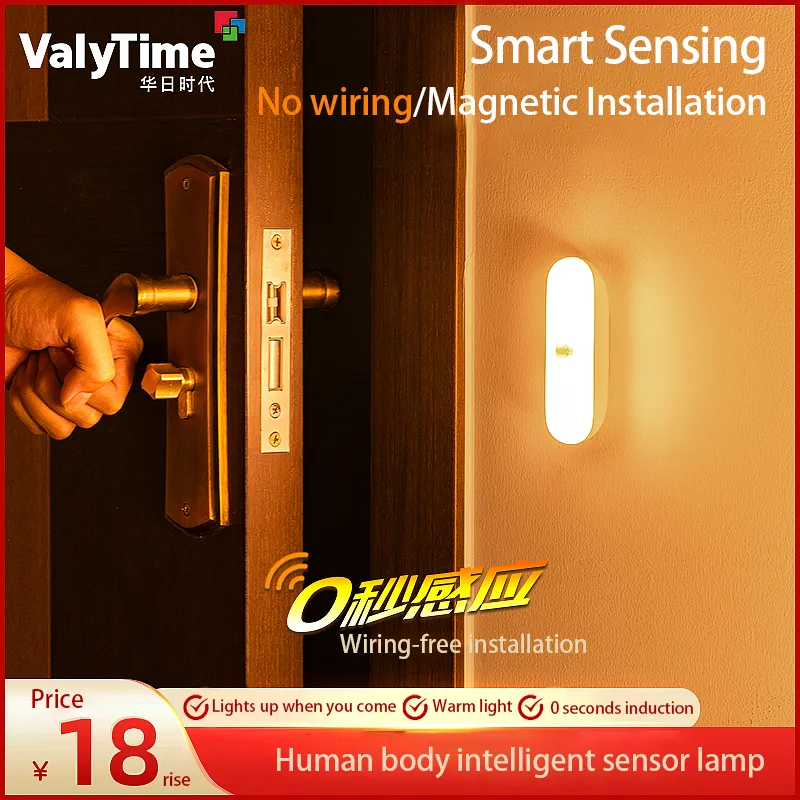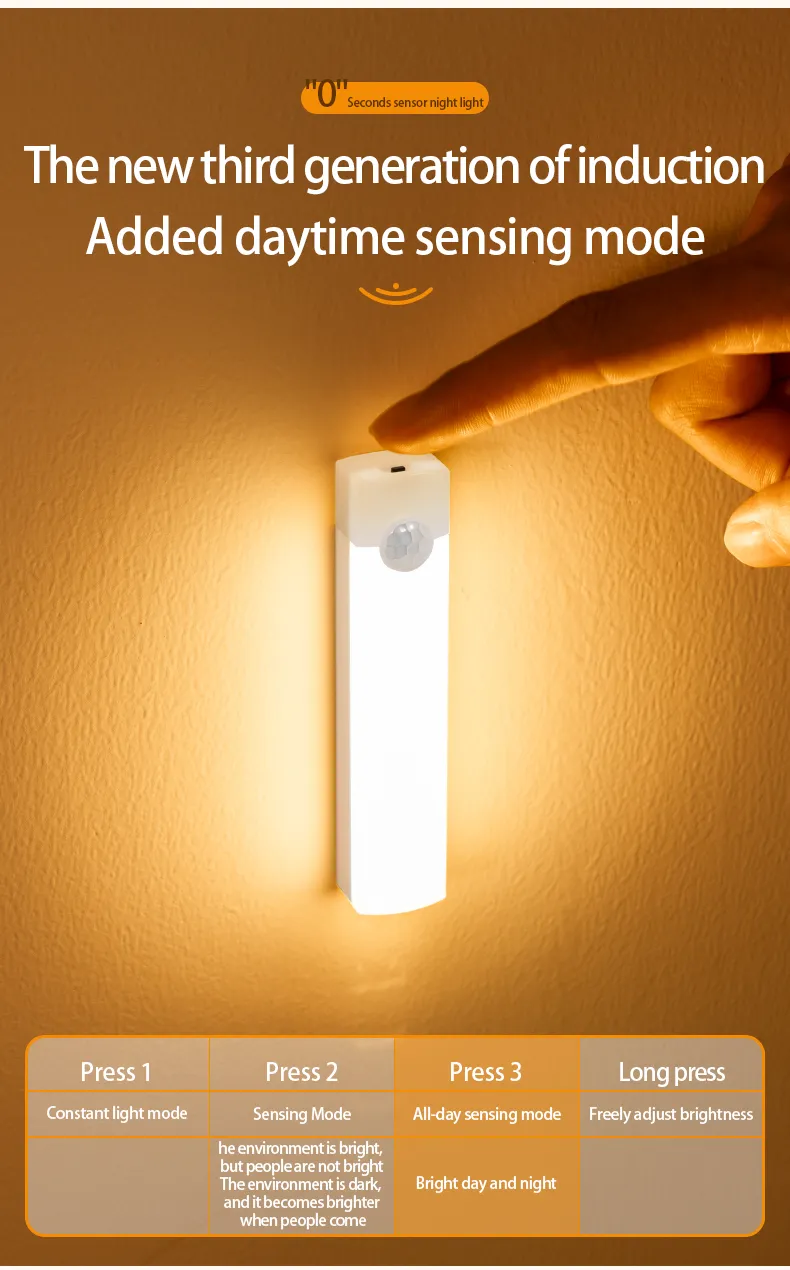Do Motion Sensor Nightlights Need WiFi?
Motion sensor nightlights, as convenient and safe lighting tools, are widely used in homes, offices, and even public spaces. Many users may have this question when purchasing a motion sensor nightlight: Does a motion sensor nightlight need WiFi?
This question involves the level of intelligence, working principle, and practical needs of motion sensor night lights.
This article will analyze in detail whether motion activated night lights need WiFi from multiple dimensions, including technical principles, functional requirements, intelligent design, and safety, to help consumers make a more informed choice.

Motion Sensor Nightlights: What are they?
A motion sensor nightlight is a lighting device that combines motion detection technology and light sensing functions, achieving automatic lighting through intelligent sensing.
Its core feature is: when the environment is dimly lit or dark, the nightlight will automatically turn on as long as it detects the movement of a person or object; and when the surroundings become bright again or there is no activity, the light will automatically turn off.
1. Motion Sensor Principle
Motion sensor nightlights typically use PIR (infrared) sensors or microwave sensors.
• PIR Sensor: Detects motion by sensing changes in thermal radiation in the environment (usually infrared radiation emitted by the human body). The PIR sensor in a motion sensor nightlight can detect nearby moving objects and trigger illumination.
• Microwave Sensor: Utilizes the principle of microwave reflection, it determines the presence of a moving target by emitting microwaves and receiving changes in the frequency of the reflected waves. Microwave sensors can accurately capture the dynamics of objects and are suitable for detection over a wide area.
2. Light Control Sensing
Motion sensor nightlights are often equipped with a light control sensing unit to measure the ambient light intensity. When the ambient light is low (e.g., at night or in dimly lit environments), the light automatically turns on. Light control sensing helps the nightlight determine whether to turn on the light, avoiding unnecessary illumination during the day or when there is sufficient light, thus achieving energy saving.
3. Power Supply Design
Many motion sensor nightlights use battery power or USB charging. Built-in battery design allows the nightlight to operate stably without a power outlet, greatly improving installation flexibility. Some high-end models also support solar power, further enhancing environmental friendliness and ease of use.

Do Motion Sensor Nightlights Need WiFi?
With the increasing popularity of smart home devices, many home appliances, including lighting systems, are beginning to feature WiFi or Bluetooth connectivity for intelligent control.
So, do motion sensor night lights need WiFi to function properly? The key question here is: do all motion sensor nightl ights have intelligent control functions? And do these functions rely on a WiFi network?
1. Basic Motion Sensor Night Lights Do Not Need WiFi
Most motion activated night lights do not rely on WiFi to operate. They use built-in sensors and light-sensing modules for automatic sensing and illumination. This means that even without a WiFi network, motion activated night lights can still trigger illumination through motion sensing and automatically adjust brightness when ambient light is insufficient.
Therefore, these basic motion activated night lights do not need a WiFi network to function. For everyday indoor areas such as hallways, kitchens, or bathrooms, WiFi is not a necessity.
For example, when installing a motion sensor nightlight in a home hallway or bedroom doorway, the user only needs to place the light fixture in a suitable location and ensure that the sensor covers the desired activity area; the light fixture will operate automatically without a network connection.
These types of nightlights are easy to install and not limited by WiFi networks, making them especially suitable for users without complex smart home systems.
2. Smart Motion Sensor Nightlights Require WiFi
However, with the continuous development of smart homes, more and more motion sensor nightlights have incorporated WiFi connectivity, becoming part of smart home systems. These smart motion sensor nightlights connect to other devices (such as smartphones, voice assistants, smart switches, etc.) via WiFi or Bluetooth to achieve a higher level of control and adjustment.
For example, users can remotely control the light's on/off state, brightness, sensor sensitivity, etc., or link it with other smart home devices through a smartphone app.
Furthermore, some advanced motion sensor nightlights also have scene setting functions, allowing users to customize different lighting modes according to their needs, such as "Goodnight Mode" or "Welcome Mode," controlled and adjusted via WiFi. These smart nightlights offer greater personalization and convenience within a home system.
Therefore, whether a smart motion sensor nightlight needs WiFi depends on the product's functionality and design. If the nightlight has smart control functions, then it does need WiFi for remote operation, linking with other smart devices, or status monitoring.

Motion Activated Night Lights: What are their application scenarios?
Motion activated night lights are ideal for various home and public environments, especially areas often in low-light conditions. Whether it's a basic non-WiFi nightlight or a smart WiFi-connected version, they effectively improve safety and convenience. Here are some typical application scenarios:
1. Home Hallways and Staircases
Hallways and staircases are the most common places in the home where falls occur at night. Installing motion sensor nightlights provides automatic lighting in dark or low-light environments, ensuring the safety of family members when moving around. These nightlights use automatic sensing to ensure they only turn on when movement occurs, avoiding the energy waste of continuously running lights.
2. Bedrooms and Bathrooms
When getting up late at night, especially in small spaces like bedrooms and bathrooms, motion activated night lights provide sufficient illumination to help family members avoid bumping into objects or falling. The presence of nightlights significantly improves safety, especially for the elderly or children.
3. Kitchens and Dining Rooms
Motion sensor night lights also have high practical value in kitchens and dining rooms. It automatically turns on at night, preventing collisions in the dark and providing a safe environment for users. Appropriate lighting helps prevent accidents during cooking or dining.
4. Public Areas and Shopping Malls
Motion sensor nightlights are becoming increasingly common in public places, especially shopping malls and parking lots. By automatically sensing motion signals, these nightlights provide necessary illumination, ensuring the safety of pedestrians at night while avoiding excessive energy waste.

Motion Sensor Nightlights: Safety and Energy Saving Features
Motion sensor night lights have several significant advantages, which is one of the important reasons for their popularity.
1. Improved Safety
At night, automatically illuminating motion activated night lights effectively prevent falls and collisions caused by dark environments. This is especially important for the elderly, children, and people with mobility impairments. The nightlight's sensing function ensures it only illuminates when needed, avoiding unnecessary energy consumption from continuous lighting.
2. Energy Saving and Environmental Protection
Compared to traditional constantly lit lamps, one of the biggest advantages of motion sensor night lights is their energy efficiency. It can determine whether to light up based on ambient light and motion detection, avoiding unnecessary lighting costs. Since most motion sensor night lights use low-energy LED bulbs, this further enhances their energy efficiency.
3. Smart Control
For smart motion sensor nightlights that support WiFi, users can remotely control them via smartphone, adjusting brightness, setting timers, and more. This smart control method offers great convenience, especially in scenarios requiring flexible lighting settings, such as night mode and energy-saving mode.
Does a motion sensor nightlight need WiFi?
To be clear: —A motion sensor nightlight does not need WiFi.
It combines the functions of a motion sensor and a photosensor, enabling automatic lighting and delayed shutdown in low-light environments, providing soft, eye-friendly lighting for spaces such as hallways, kitchens, bathrooms, and bedrooms. Its advantages lie in its intelligence, adaptability, energy efficiency, and safety, all achieved entirely through a local sensing system.
While WiFi functionality can be an extension of smart home technology, it is not a core requirement for motion sensor nightlights. For most users, a motion sensor nightlight that can operate independently without Wi-Fi is the most practical and convenient lighting option for home life.
Does Huari Lighting offer marketing or promotional support?
Yes, our sales department provides product photos, technical sheets, and specification data for use in catalogs and online listings. For long-term partners, we can offer marketing collaborations such as co-branded packaging or special discount campaigns.
We believe in supporting our clients beyond manufacturing—helping them sell faster and achieve better market performance with affordable, certified, and attractive LED lighting solutions from China.
